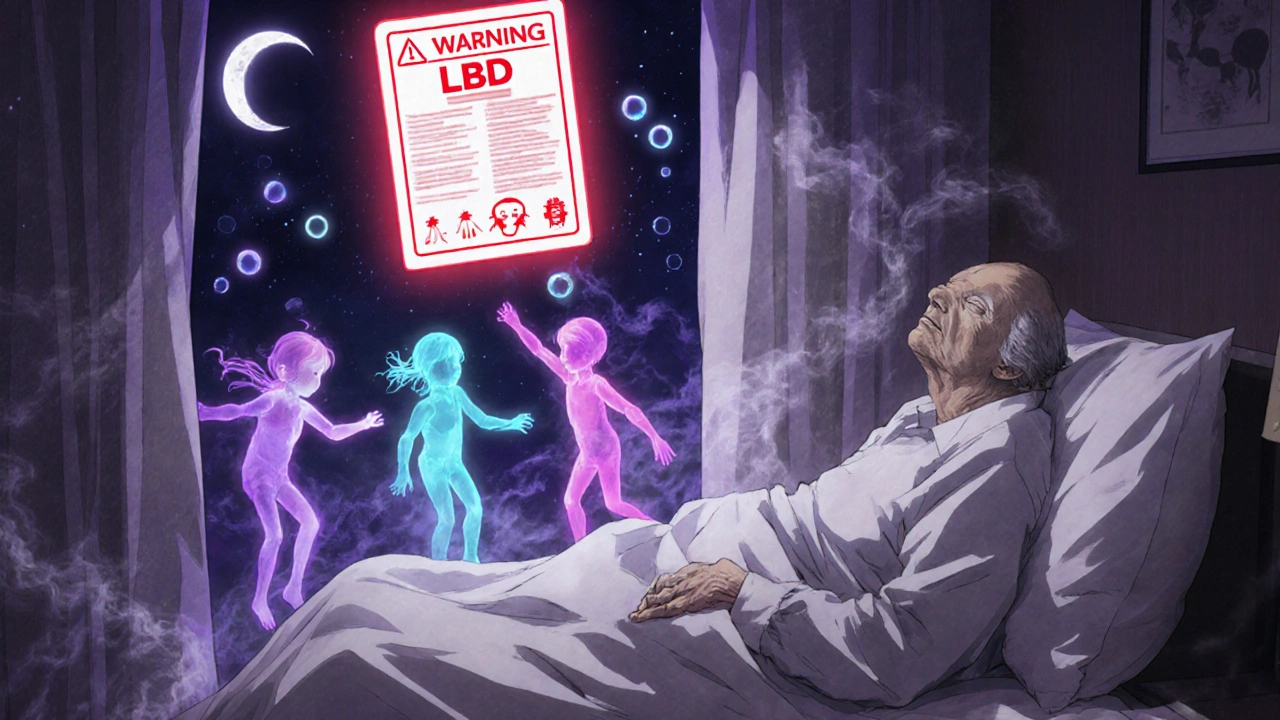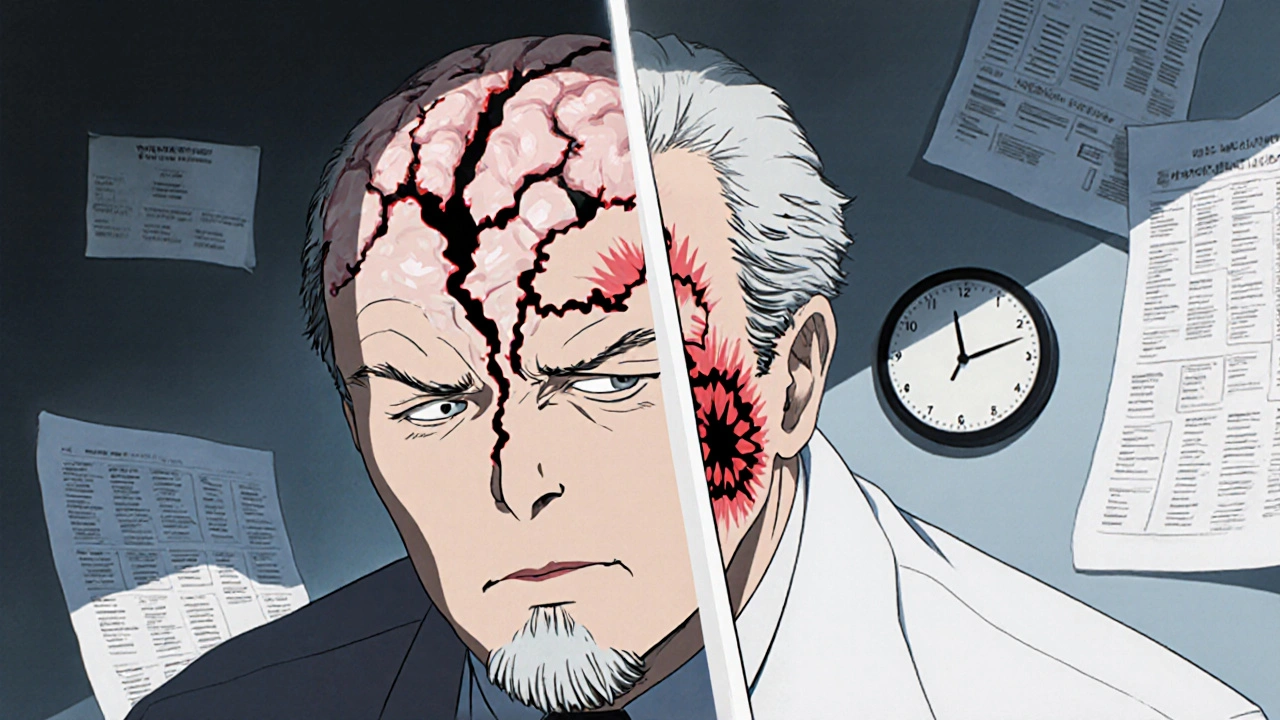Not all dementia is the same
When someone says "dementia," most people picture memory loss-forgetting names, repeating questions, getting lost in familiar places. But that’s only part of the story. Vascular dementia, frontotemporal dementia (FTD), and Lewy body dementia (LBD) are three very different conditions that all fall under the dementia umbrella. They affect different parts of the brain, show up in different ways, and need completely different care. Getting the right diagnosis isn’t just about labeling-it changes everything from treatment to safety to how families plan for the future.
Vascular dementia: The silent damage from blocked blood flow
Vascular dementia happens when blood flow to the brain is interrupted. It’s not caused by dying brain cells from protein buildup, like in Alzheimer’s. It’s caused by strokes, mini-strokes (TIAs), or long-term damage from high blood pressure, diabetes, or clogged arteries. Every time a blood vessel gets blocked or bursts, a small area of brain tissue dies. Over time, these tiny injuries add up.
Unlike Alzheimer’s, where memory fades slowly, vascular dementia often shows up in steps. A person might seem fine one month, then suddenly struggle to follow a conversation or forget how to pay bills after a stroke. Then they stabilize for a while-only to decline again after another vascular event. This pattern is a major red flag.
Symptoms go beyond memory. People with vascular dementia often have trouble with planning, organizing, and making decisions. They might walk unsteadily, lose bladder control, or feel emotionally flat. Hallucinations and delusions can happen too, especially if the damage is in the frontal lobes. The biggest risk? Another stroke. That’s why managing blood pressure (under 130/80 mmHg), cholesterol, and blood sugar isn’t just helpful-it’s essential. Medications like aspirin or statins can slow progression, but only if started early.
Frontotemporal dementia: When personality changes before memory does
FTD is the dementia that catches families off guard because it hits younger people-often in their 50s or 60s-and the first signs look nothing like Alzheimer’s. Instead of forgetting where they put their keys, someone with FTD might start acting completely out of character. They might make inappropriate comments, spend money recklessly, lose all interest in family, or eat compulsively. Some become emotionally numb. Others cry or laugh at the wrong times.
This isn’t a psychiatric issue. It’s brain shrinkage. FTD targets the frontal and temporal lobes-the parts that control behavior, judgment, language, and social rules. Brain scans show clear atrophy in these areas. Memory stays strong for a long time, which is why it’s often mistaken for depression, bipolar disorder, or even midlife crisis. Up to half of FTD cases are misdiagnosed at first.
There are three main types. Behavioral variant FTD causes personality shifts. Primary progressive aphasia affects speech-some people struggle to find words, others speak fluently but say nonsense. A third group develops movement problems like muscle stiffness or tremors, similar to Parkinson’s. There’s no cure. Medications like SSRIs can help with impulsivity or mood swings, but they don’t stop the disease. Speech therapy helps with language loss. The hardest part? Families often don’t recognize the changes as illness-they think their loved one is being selfish or lazy. Education is the first step to better care.

Lewy body dementia: The tricky mix of brain fog, hallucinations, and movement issues
Lewy body dementia is one of the most misunderstood types. It’s not one disease-it’s two. Dementia with Lewy bodies (DLB) and Parkinson’s disease dementia (PDD) are the same condition, just diagnosed differently based on timing. If dementia comes first-or within a year of movement problems-it’s DLB. If Parkinson’s symptoms come first and dementia follows after a year or more, it’s PDD.
What makes LBD so dangerous? Three core signs: fluctuating attention, visual hallucinations, and Parkinson-like movement issues. A person might be alert and talking clearly one minute, then zone out, stare blankly, and not respond the next. They might see people or animals that aren’t there-often detailed and vivid, like a child playing in the corner. These hallucinations aren’t always scary to the person; they might just comment on them calmly.
They also have movement problems: stiff muscles, slow steps, shuffling gait, reduced facial expression. Many have REM sleep behavior disorder-acting out dreams, kicking, yelling in their sleep. And here’s the critical warning: standard antipsychotic drugs used for hallucinations in Alzheimer’s can be deadly in LBD. Up to 75% of people with LBD have severe, even fatal reactions to these medications. Even mild ones like haloperidol can cause sudden stiffness, fever, or cardiac arrest.
Doctors use cholinesterase inhibitors like rivastigmine to help with thinking and hallucinations. Sleep and movement symptoms are managed with other targeted drugs. Diagnosis relies on specific criteria: at least two core symptoms plus supporting evidence from brain scans like DaTscan. Misdiagnosis is common-up to 75% of LBD cases are initially called Alzheimer’s. That’s why getting the right diagnosis can reduce hospital stays by 30%.
Why the differences matter more than you think
These three types aren’t just different in symptoms-they need different treatments, different safety plans, and different caregiver strategies. Giving someone with LBD an antipsychotic meant for Alzheimer’s can kill them. Prescribing a memory drug like donepezil to someone with vascular dementia might do nothing if their blood pressure isn’t controlled. Treating FTD like depression with antidepressants alone misses the neurological root.
Diagnosis requires more than a memory test. Vascular dementia needs MRI scans to spot strokes or white matter damage. FTD requires brain imaging showing frontal/temporal shrinkage and neuropsychological testing focused on behavior and language-not memory. LBD needs evaluation of cognitive fluctuations, hallucinations, and movement, often confirmed with DaTscan.
And the stakes are high. The Alzheimer’s Association estimates that up to 40% of people with Alzheimer’s also have Lewy bodies, making diagnosis even harder. Many patients are caught in the middle-showing mixed symptoms. That’s why specialists in memory disorders are critical. General neurologists might miss the subtleties. A dementia clinic with experience in all three types gives the best shot at accurate diagnosis.

What you can do now
If you or someone you know is showing signs of dementia, don’t wait. Early detection makes a difference. Track changes: Is memory fading slowly, or did behavior change suddenly? Are hallucinations happening? Is movement getting stiff? Write it down. Bring it to a doctor who specializes in dementia-not just a primary care provider.
Ask for brain imaging. Ask about blood pressure and diabetes control. Ask if the symptoms fit vascular, frontotemporal, or Lewy body patterns. Don’t accept a vague "it’s probably Alzheimer’s" answer. Push for clarity. The right diagnosis means better medication choices, fewer dangerous side effects, and more realistic planning.
For caregivers: Learn the signs of each type. LBD hallucinations aren’t always delusions-they’re part of the disease. FTD personality changes aren’t defiance-they’re brain damage. Vascular dementia isn’t just aging-it’s a warning sign of heart and blood vessel problems. Knowledge isn’t just helpful. It’s protective.
What’s on the horizon
Research is moving fast. Blood tests are being developed to detect early signs of vascular injury or abnormal proteins. For LBD, drugs targeting alpha-synuclein (the protein forming Lewy bodies) are in clinical trials. For FTD, gene therapies are being tested in people with inherited forms. And the SPRINT-MIND trial proved that lowering blood pressure to under 120 mmHg reduces the risk of mild cognitive decline by 19%-a powerful reminder that what’s good for the heart is good for the brain.
But funding still lags. Alzheimer’s gets billions in research dollars. LBD and FTD together get less than $50 million annually-despite affecting millions. That’s changing slowly, but awareness is the first step. Talk about it. Ask questions. Demand better diagnostics. Because when it comes to dementia, not all types are created equal-and understanding the difference saves lives.


Sam txf
November 28, 2025 AT 10:37This post is a goddamn masterpiece. Most people think dementia is just old folks forgetting where they put their damn keys, but nah - it’s a fucking orchestra of brain rot, and nobody’s listening. Vascular dementia? That’s your blood pressure screaming for help. FTD? Your uncle’s ‘midlife crisis’ is his frontal lobe dissolving. And LBD? Don’t even get me started on how hospitals poison people with antipsychotics like they’re treating a bad trip. This isn’t aging - it’s a systemic failure.